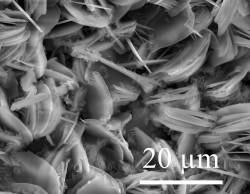Abstract
Luminescent organic/inorganic matrix that contains tris(beta-diketonate) complexes of cations of two different lanthanides (europium and terbium). Optionally, the matrix comprises coated magnetic iron-oxide nanoparticles. The matrix may be composed of inorganic polymers based on siloxane that are derivatized with organic groups (for example, diureasil, diurethanosil or any other amino-functionalized hybrid). The method for producing the matrix comprises preparing solutions of tris(beta-diketonate) complexes of lanthanide cations and polymerizing a precursor mixture for the matrix that contains solutions of said complexes. A luminescent molecular thermometer comprises the above matrix, an excitation source and equipment for detecting luminescence. Eu(III) emission intensity is independent of temperature, which allows autocalibration of the thermometer. Absolute temperature is measured by comparing the relative intensity between Tb(III) and Eu(III) emissions.
Innovative aspects & main advantages
In the biomedical field that multifunctionality can lead to a unique instrumentation for determining temperature distributions in biological tissues such as tumors, during hyperthermic treatment processes.
The luminescent molecular thermometer is self-calibrating and it allows the determination of the absolute temperature in long-term use.
The new thermometer does not require an external reference for temperature measuring, allowing absolute measurements in the 10–350 K (-263 to 77 ºC) temperature range.
The temperature measurement of the emission intensity using a simple optical instrument is easier, cheaper and faster, with very high spatial resolution.
It may be prosecuted as paint by providing a map of temperature distribution with very high spatial resolution.
This thermometer allows the variation of the maximum sensitivity temperature range by a molecular redesign.
The luminescent molecular thermometer is non-contact, with micrometer and nanometer spatial resolution (1 million times smaller than a millimeter).
It works remotely by an optical detection system, even within biological fluids, strong electromagnetic fields and fast moving objects.
Its temperature sensitivity is up to 4.9%/K, 1.5 times larger than the highest value reported so far for temperature sensors based on lanthanide.
Applications
Nanothermometers will find applications where the temperature control at sub-micrometric scale is critical, such as in electronics (e.g. localization of hot-spots in integrated circuits), chemical engineering (e.g. temperature in catalytic processes), thermodynamics (e.g. temperature to quantify heat transfer in solids and suspensions) and biomedicine (e.g. intracellular temperature mapping).
Inventors
Palacio, Fernando; Escolano, Angel; Silva, Nuno; Carlos, Luis ; Amaral, Vitor; Lima, Patricia; Brites, CarlosOur Inventors
Applicant
Consejo Superior de Investigaciones CientificasUniversidade de Aveiro
















